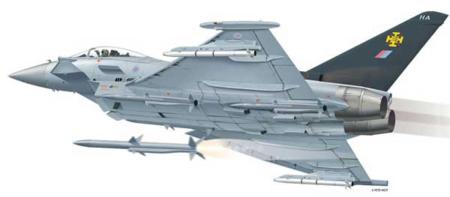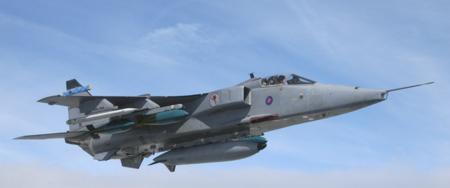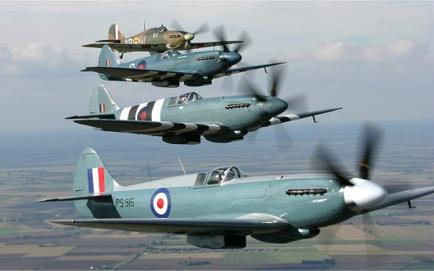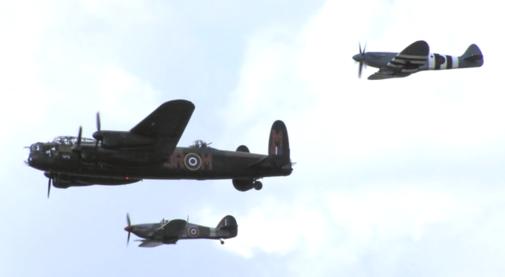 |
RAF ConingsbyTyphoon Country |
|
RAF Coningsby, having started life as a wartime bomber airfield, has now evolved into the RAF’s foremost fighter base, responsible for the evolution of the Services air defence tactics and doctrine. As part of Number 1 Group, RAF Coningsby is one of the three air defence fighter bases in the United Kingdom.This new phase in the Stations history was heralded with the relocation of 17(Reserve) Squadron, the Operational Evaluation Unit, to Coningsby on 1 April 2005, with the tasking of bringing the Typhoon aircraft into service. On the 4 November 2005 29(Reserve) Squadron stood up as the Operational Conversion Unit, training pilots on the Typhoon.
Picture by Geoffrey Lee - Typhoon
On 31 March 2006, 3(Fighter) Squadron (Harrier) at RAF Cottesmore moved to Coningsby to operate as 3(Fighter) Squadron, the first Operational Typhoon Squadron. The formation of 3(F) Sqn marks the beginning of the transition of the Royal Air Force to a more agile, capable, flexible and adaptable expeditionary force, better equipped to meet the demands that are likely to be placed on it in the future. On the same day the Fast Jet and Weapons Operational Evaluation Unit acquired Squadron status when it was renamed as 41(Reserve) Squadron. The latest Coningsby acquisition is 6 Squadron who relocated from RAF Coltishall to RAF Coningsby on the 1 April 2006 to fly the remainder of the Jaguar fleet until its disbandment.
Jaguar of 6 SqdnOn the 1 April 2006, 121 Expeditionary Air Wing (121 EAW) was formed. The concept of forming this wing within the Air Force will provide a deployable air force structure, configured to provide discreet units of agile interoperable and capable air power. RAF Coningsby is one of nine RAF Stations which will train individuals units to provide Multi-role capability. Coningsby has operated as 121 EAW twice before, once in1945 flying Typhoon Fighters and again in 1956 with Venom Fighters, as part of the 2nd Tactical Air Force.
J 33 - De Havilland 112 NF.51 Venom (1953-1960)The past year has seen many changes across the Station but they have
demonstrated that Royal Air Force Coningsby has maintained its place
firmly at the forefront of the Royal Air Force. Part 1: World War II to PhantomsIt was in 1937 that work on building an aerodrome at Coningsby was started. At the outbreak of war it was still under construction and did not become a Royal Air Force Station until 4 November 1940, as a bomber airfield in No 5 Group. The first squadron, No 106, arrived in February 1941 and operations began the following month when 4 Hampdens bombed Cologne. No 97 Squadron, equipped with Manchester, followed in April and took part in bombing and mining operations, which were the Station's main tasks at that time. Coningsby aircraft flew in the famous Thousand Bomber' raid on Cologne in May 1942, but from September 1942 to August 1943, whilst hard runways were laid, offensive activities ceased.
Hampden of 44 SquadronNo 617 Squadron - The Dambusters' - under the command of Wing Commander Guy Gibson VC, flew Lancasters from here from August 1943 until January 1944, when they moved to the nearby airfield of Woodhall Spa. The Squadron's Mess is now the popular Petwood Hotel. Early in 1944 a special Marker Force was formed within No 5 Group and this Force operated from Coningsby and its satellite airfields at Woodhall Spa and Metheringham. The Marker Force achieved outstanding results and the skill of its crews was largely responsible for the night bombing successes of the last 15 months of the war.
Lancaster 0f 115 SquadronThe Station operated Lincolns for a short period after the war, before Mosquitos replaced these, in 1946. In March 1950 these too left and for 6 months the Station was inactive until the squadrons re-equipped with Washington aircraft. These remained until 1953 when the squadrons entered the jet age, re-equipping with Canberras, the RAF's first jet heavy bomber. In 1954 a tremendous expansion of the Station began, including extension of the runways, and it was closed for flying that year with the work not being finally completed until late 1956.
Canberra of 115 SquadronThe Canberras left in 1961 and from 1962 to November 1964, 3 squadrons of Vulcans, Nos 9,12 and 35, were based at Coningsby. During this period, in May 1963, the Station received the Freedom of the Borough of Boston. In 1964 the Station was selected as the prospective base for the ill-fated TSR2 and, at the end of the year, the Station was placed under Care and Maintenance following the cancellation of the project. In 1966 Coningsby was selected as the first base for the RAF fighter-bomber version of the Phantom and it transferred from Bomber Command to Fighter Command. Another period of tremendous building activity, costing some £4.5 million, commenced. In December 1967, because of the initial roles the Phantom was to perform, the Station was transferred from Fighter Command to Air Support Command. At the same time, the first ground training course for airmen on the Phantom's systems was started at the No 5 School of Technical training which, in August 1968, became No 3 Squadron of No 228 Operational Conversion Unit. In August 1968 the Phantom FGR 2 arrived at Coningsby, and, in October, the first aircrew course on the OCU was started in preparation for the formation at Coningsby of the first Phantom squadrons. In October 1974 the Station transferred from No 38 Group to No 11 Group, within the now renamed Strike Command, as its primary role changed from ground attack to air defence.
Phantom FGR of 26 SquadronIn March 1976 the Battle of Britain Memorial Flight, which maintains and flies the last of the Royal Air Force's Spitfires and Hurricanes, a Lancaster Bomber and a Dakota, moved to Coningsby from Coltishall. In 1977 Her Royal Highness, the Princess Margaret, became Honorary Air Commodore of Royal Air Force Coningsby and visited the Station on a bi-annual basis, until her death on 15 February 2002. In June 1981 the airfield hardening programme, designed to offer greater protection to aircraft and personnel, began and was finally completed in October 1984. The runway was resurfaced from 1 March until 31 October 1984 during which period operations were carried out from Waddington. The arrival of the first Tornado F2 aircraft in November 1984 heralded the next phase in Coningsby's long and varied history. No 229 Operational Conversion Unit was re-formed on 1 November 1984 and quickly began providing crews for the front-line squadrons. The unit was renamed 56 (Reserve) Squadron in July 1992. During 1987, No 29(F) Squadron gradually phased out its Phantoms and became the first squadron to re-equip with the Tornado F3. Part 2: The Tornado Years
Tornado GR4 of 13 SquadronIn April 1987 the Phantom Operational Conversion Unit moved from Coningsby to Leuchars and, with the arrival in February 1988 of No 5 (AC) Squadron, the Station was now fully committed to Tornado operations. In line with this change of aircraft, the Tornado Air Intercept Trainer was installed in 1985, and was followed by an Air Combat Simulator and, finally, two Mission Simulators in 1988. Additionally, a modern deep-strip facility for the Tornado's Turbo-Union RB199 engines was installed at the former 'Dambusters' base at Woodhall Spa. Both Nos 5(AC) and 29(F) Squadrons played an important part in the Gulf conflict; No 5(AC) Squadron was deployed to the Gulf for 3 months in August 1990, flying air defence missions out of Dhahran, whilst No 29(F) Squadron operated out of Saudi Arabia for 3 months from December 1990, flying over 500 missions. Both squadrons were again involved with out of area operations for Operation DENY FLIGHT, flying out of the southern Italian Base of Gioia del Colle to police the no-fly zone over Bosnia. Additionally, both Station and Squadron continued to support the RAF commitment at Mount Pleasant Airfield in the Falkland Islands and No 5(AC) Squadron was deployed to Al Kharj in support of Op BOLTON. As a result of the Strategic Defence Review, 29(F) Squadron was disbanded in October 1998, a sad occasion for all involved. Further difficult times were encountered when No 5(AC) Squadron was disbanded in September 2002, followed, not long after, by the relocation of 56(R) Squadron to RAF Leuchars in March 2003. The losses the last remaining Squadrons were compounded by runway renewal works causing the temporary relocation of BBMF through the summer of 2003, leaving RAF Coningsby quiet and superficially subdued. However, beneath the facade there was much work being done and many grounds for optimism.
In addition to the Battle of Britain Memorial Flight and the essential administrative and engineering support needed to run a modern frontline station; Coningsby is also home to the Fast Jet and Weapons Operational Evaluation Unit. Their role is to trial any modifications or improvements to the aircraft and to develop the tactics and doctrine to be used by all fast jet squadrons.
Typical formation: Hawker Hurricane, Avro Lancaster and Supermarine SpitfireThe Battle of Britain Memorial Flight (BBMF) is a Royal Air Force flight which provides an aerial display group comprising an Avro Lancaster, a Supermarine Spitfire and a Hawker Hurricane. The aircraft are regularly seen at events commemorating World War II, upon British State occasions, notably the Trooping the Colour celebrating Queen Elizabeth II's 80th birth day in 2006, and at air displays throughout the United Kingdom and Europe. The Flight is administratively part of No. 1 Group RAF, flying out
of RAF Coningsby in Lincolnshire. RAF Coningsby is home to the most diverse collection of flying aircraft in the Royal Air Force: Fast jets: Typhoon T1 and F2; Tornado F3; Tornado GR4; Harrier GR9; Jaguar GR3. Propellor-driven aircraft: Spitfire, Hurricane, Lancaster and Dakota and Chipmunk of the Battle of Britain Memorial Flight. Viewing Area To watch aircraft movements a viewing area car park is located on Dogdyke Road, Coningsby which is open to the general public. Station Address Officer Commanding, RAF Coningsby, Lincoln LN4 4SY Contacts If you wish to make a request to visit Royal Air Force Coningsby, please contact one of the following for further information: Air Training Corps: Air Training Liaison Officer 01526 346370 / 346354
Images: With thanks to Roger Dunn, Geoffrey Lee &
Key Publishing
|










